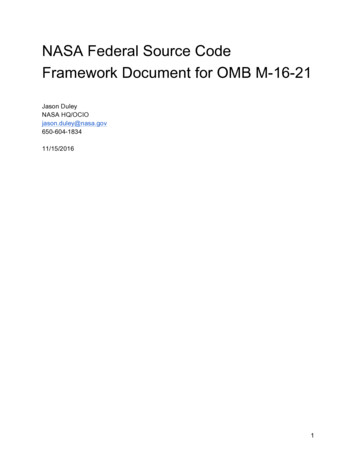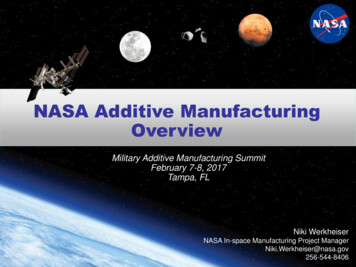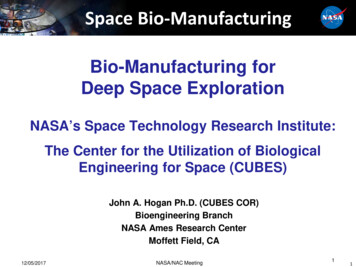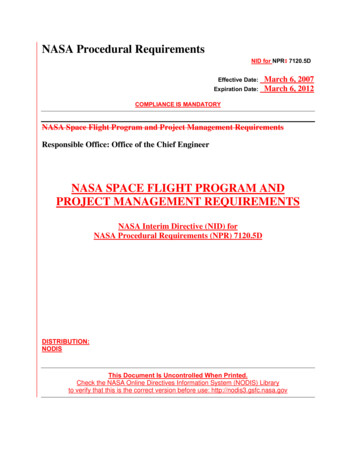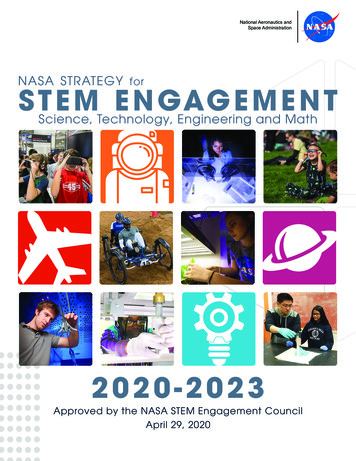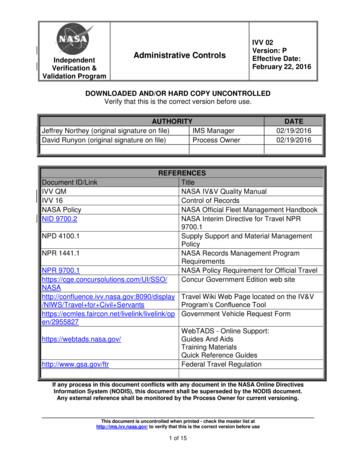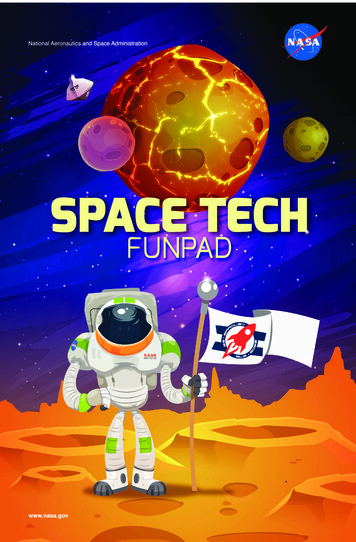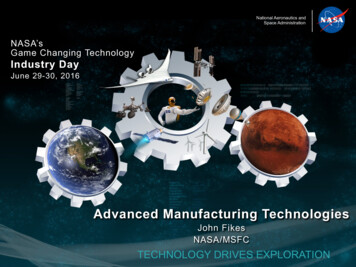
Transcription
National Aeronautics andSpace AdministrationNASA’sGame Changing TechnologyIndustry DayJune 29-30, 2016Advanced Manufacturing TechnologiesJohn FikesNASA/MSFCTECHNOLOGY DRIVES EXPLORATION
Advanced Manufacturing TechnologiesØ Advanced Manufacturing Technologies (AMT) is developing andmaturing innovative and advanced manufacturing technologies that willenable more capable and lower-cost spacecraft, launch vehicles andinfrastructure to enable exploration missions.Ø The technologies will utilize cuttingedge materials and emergingcapabilities including metallicprocesses, additive manufacturing,composites, and digital manufacturing.Ø The AMT project supports the NationalManufacturing Initiative involvingcollaboration with other governmentagencies.
Low Cost Upper Stage-Class PropulsionDevelopment (LCUSP)Problem: The ability to produce innovative lowcost upper stage-class propulsion systems usingadditive manufacturing technologies.Technology/Solution: Utilize additive E-beamand SLM additive manufacturing techniques toproduce a 25K-class hydrogen cooled propulsionchamber from GRCop and Inconel 625.Innovation: This is a game changing technologythat utilizes additive manufacturing to achievecost and schedule savings by demonstratingcritical material properties and performance.Capability: A GRCop/Inconel 625 25K-classhydrogen cooled/regenerative propulsionchamber with a high thermal conductivity wall,structural capability and closed out printedchannels.HotFireTes turerocketenginecomponents.
Low Cost Upper Stage-Class PropulsionPartnershipsØ Build foundational additive manufacturing industrialbase by sharing engine chamber and nozzle materialproperty data, relevant design data, and test data.Ø Future partnerships with commercial space industrycould include materials development, additivemanufacturing of engine components, machiningtechniques, sharing of test data and test infrastructure.Ø Both industry and NASA can benefit by reducing costand schedule for new upper stage engines and enablenew designs previously impossible with conventionalfabrication methods.Ø NASA will continue to mature advanced manufacturingtechnologies by performing hot fire testing of theLCUSP additive manufactured chambers and nozzle,performing material property testing and building up theengine test infrastructure.
Additive Manufacturing forTurbomachineryProblem: Reduce the cost and lead time for delivery ofturbopump assemblies for upper stage propulsionsystems.Technology/Solution: Complete the build and assemblyof one oxygen turbopump using additive manufacturing,demonstrate additive manufactured rotating and highpressure turbopump components in oxygen and infusetechnology into the design process.Innovation: This is a game changing technology thatdemonstrates critical oxygen turbopump hardware canbe additively manufactured, integrated into a turbopumpassembly, and successfully tested in liquid oxygen.Capability: A demonstrated turbopump that can beincorporated into the Additive ManufacturingDemonstrator Engine (AMDE) for engine hot-fire testingor used for future LOX/Methane demonstrator engines.
Additive Manufacturing for TurbomachineryPartnershipsØ Build foundational additive manufacturing industrial base byworking through the builds of complex additive manufacturingturbopump part geometries with outside vendors to increasetheir build capabilities and confidence. Share lean and aggressive development philosophy. Share test data for turbomachinery operating in liquid oxygen.Ø Future partnerships with commercial space industry couldinclude materials development, additive laser sinter meltingmanufacturing of engine components, post build machiningtechniques, and sharing of test data and test infrastructure.Ø Both industry and NASA benefit by reducing cost and leadtime for turbomachinery. This applies to all future liquidpropulsion systems including upper stage and in-spaceengines.Ø NASA will continue to mature advanced manufacturingtechnologies by performing material property testing and hotfire testing of additive manufactured engine parts.
Additive Construction with MobileEmplacement (ACME)Problem: NASA currently lacks in-spaceconstruction capabilities to fabricate deepspace mission infrastructure using in-situmaterials.Technology/Solution: Develop additiveconstruction techniques and materials usingknown in-situ resources to enable humanexploration missions.Innovation: This is a game changingtechnology that develops capability to utilize insitu resources to fabricate planetary surfaceinfrastructure, including habitats, garages,roads, and berms, with minimal mass launchedfrom Earth.Capability: Demonstrated additive construction capabilitywith terrestrial and in-space applications.
ACME PartnershipsØ NASA and the United States Army Corps of Engineers are jointlyinvesting in additive construction technologies.Ø NASA is holding a new 2.25 million competition to design andbuild a 3-D printed habitat for deep space exploration, including theagency’s journey to Mars.Ø NASA is working with Contour Crafting Corporation, a smallbusiness that owns the Intellectual Property to an additiveconstruction technique.Ø Future partnerships with industry could include additiveconstruction, materials development, and sharing of data.Ø Both industry and NASA benefit by reducing cost and schedule toenable future exploration missions by reducing launch massrequirements, improving space infrastructure affordability andapplying technology to terrestrial needs.Ø NASA will continue to mature advanced manufacturing technologies by performing materialproperty testing and building a representative structure to demonstrate additive construction.
Contact InformationFor more information about this technology or to discuss potentialcollaboration efforts:JohnFikesjohn.fikes@nasa.gov256- ‐544- ‐5570
additive manufacturing technologies. Technology/Solution: Utilize additive E-beam and SLM additive manufacturing techniques to produce a 25K-class hydrogen cooled propulsion chamber from GRCop and Inconel 625. Innovation: This is a game changing technology that utilizes additive manufacturing to achieve cost and schedule savings by demonstrating
